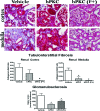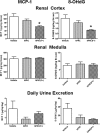Cell therapy with human renal cell cultures containing erythropoietin-positive cells improves chronic kidney injury
- PMID: 23197816
- PMCID: PMC3659702
- DOI: 10.5966/sctm.2011-0048
Cell therapy with human renal cell cultures containing erythropoietin-positive cells improves chronic kidney injury
Abstract
New therapeutic strategies for chronic kidney disease (CKD) are necessary to offset the rising incidence of CKD and donor shortage. Erythropoietin (EPO), a cytokine produced by fibroblast-like cells in the kidney, has recently emerged as a renoprotective factor with anti-inflammatory, antioxidant properties. This study (a) determined whether human renal cultures (human primary kidney cells [hPKC]) can be enriched in EPO-positive cells (hPKC(F+)) by using magnetic-bead sorting; (b) characterized hPKC(F+) following cell separation; and (c) established that intrarenal delivery of enriched hPKC(F+) cells would be more beneficial in treatment of renal injury, inflammation, and oxidative stress than unsorted hPKC cultures in a chronic kidney injury model. Fluorescence-activated cell sorting analysis revealed higher expression of EPO (36%) and CD73 (27%) in hPKC(F+) as compared with hPKC. After induction of renal injury, intrarenal delivery of hPKC(F+) or hPKC significantly reduced serum creatinine, interstitial fibrosis in the medulla, and abundance of CD68-positive cells in the cortex and medulla (p < .05). However, only hPKC(F+) attenuated interstitial fibrosis in the renal cortex and decreased urinary albumin (3.5-fold) and urinary tubular injury marker kidney injury molecule 1 (16-fold). hPKC(F+) also significantly reduced levels of renal cortical monocyte chemotactic protein 1 (1.8-fold) and oxidative DNA marker 8-hydroxy-deoxyguanosine (8-OHdG) (2.4-fold). After 12 weeks, we detected few injected cells, which were localized mostly to the cortical interstitium. Although cell therapy with either hPKC(F+) or hPKC improved renal function, the hPKC(F+) subpopulation provides greater renoprotection, perhaps through attenuation of inflammation and oxidative stress. We conclude that hPKC(F+) may be used as components of cell-based therapies for degenerative kidney diseases.
Figures







Similar articles
-
Erythropoietin ameliorates renal ischemia and reperfusion injury via inhibiting tubulointerstitial inflammation.J Surg Res. 2012 Jul;176(1):260-6. doi: 10.1016/j.jss.2011.06.035. Epub 2011 Jul 19. J Surg Res. 2012. PMID: 21816412
-
Increased progression to kidney fibrosis after erythropoietin is used as a treatment for acute kidney injury.Am J Physiol Renal Physiol. 2014 Mar 15;306(6):F681-92. doi: 10.1152/ajprenal.00241.2013. Epub 2014 Jan 8. Am J Physiol Renal Physiol. 2014. PMID: 24402097
-
Renal Cell Protection of Erythropoietin beyond Correcting The Anemia in Chronic Kidney Disease Patients.Cell J. 2014 Winter;15(4):378-80. Epub 2013 Nov 20. Cell J. 2014. PMID: 24381864 Free PMC article.
-
Renoprotection and Mechanisms of Erythropoietin and Its Derivatives Helix B Surface Peptide in Kidney Injuries.Curr Protein Pept Sci. 2017;18(12):1183-1190. doi: 10.2174/1389203717666160909144436. Curr Protein Pept Sci. 2017. PMID: 27634442 Review.
-
The influence of the pleiotropic action of erythropoietin and its derivatives on nephroprotection.Med Sci Monit. 2013 Jul 22;19:599-605. doi: 10.12659/MSM.889023. Med Sci Monit. 2013. PMID: 23872600 Free PMC article. Review.
Cited by
-
Erythropoietin produced by genetic-modified NIH/3T3 fibroblasts enhances the survival of degenerating neurons.Brain Behav. 2015 Aug;5(8):e00356. doi: 10.1002/brb3.356. Epub 2015 Jun 3. Brain Behav. 2015. PMID: 26357589 Free PMC article.
-
Potential Use of Autologous Renal Cells from Diseased Kidneys for the Treatment of Renal Failure.PLoS One. 2016 Oct 24;11(10):e0164997. doi: 10.1371/journal.pone.0164997. eCollection 2016. PLoS One. 2016. PMID: 27776163 Free PMC article.
-
Implantation of Autologous Selected Renal Cells in Diabetic Chronic Kidney Disease Stages 3 and 4-Clinical Experience of a "First in Human" Study.Kidney Int Rep. 2016 Jul 16;1(3):105-113. doi: 10.1016/j.ekir.2016.07.001. eCollection 2016 Sep. Kidney Int Rep. 2016. PMID: 29142919 Free PMC article.
-
Human CD133+ Renal Progenitor Cells Induce Erythropoietin Production and Limit Fibrosis After Acute Tubular Injury.Sci Rep. 2016 Nov 17;6:37270. doi: 10.1038/srep37270. Sci Rep. 2016. PMID: 27853265 Free PMC article.
-
The Delivery of the Recombinant Protein Cocktail Identified by Stem Cell-Derived Secretome Analysis Accelerates Kidney Repair After Renal Ischemia-Reperfusion Injury.Front Bioeng Biotechnol. 2022 May 11;10:848679. doi: 10.3389/fbioe.2022.848679. eCollection 2022. Front Bioeng Biotechnol. 2022. PMID: 35646873 Free PMC article.
References
-
- Al-Awqati Q, Oliver JA. Stem cells in the kidney. Kidney Int. 2002;61:387–395. - PubMed
-
- Benigni A, Morigi M, Remuzzi G. Kidney regeneration. Lancet. 2010;375:1310–1317. - PubMed
-
- Guo JK, Cantley LG. Cellular maintenance and repair of the kidney. Annu Rev Physiol. 2010;72:357–376. - PubMed
-
- U.S. Renal Data System. Minneapolis, MN: U.S. Renal Data System Coordinating Center; 2009. U.S. Renal Data System Annual Report.
-
- Zenovich AG, Taylor DA. Cell therapy in kidney disease: Cautious optimism … but optimism nonetheless. Perit Dial Int. 2007;27(suppl 2):S94–S103. - PubMed
Publication types
MeSH terms
Substances
LinkOut - more resources
Full Text Sources
Other Literature Sources
Medical
Research Materials

